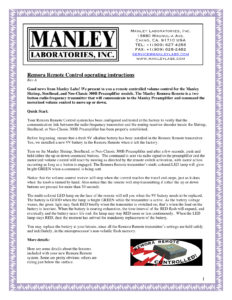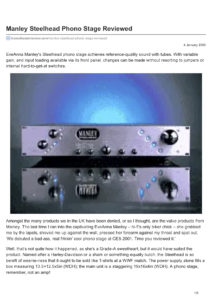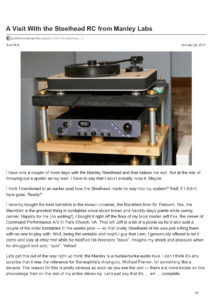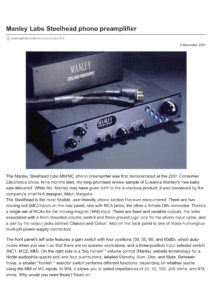Manley Steelhead RC Phonostage
“Overall, the Steelhead delivered the best vinyl playback I’ve heard from my system. It combined speed, frequency extension, resolution, harmonic structure, focus, air, stage depth, image specificity, and, most important, overall musical coherence in a way that made the music seem to fly from the speakers unrestrained by mechanical or electrical bounds.” — Michael Fremer, Stereophile, December 2001
“…the Steelhead is a very fine phonostage. And no, you’re not just paying for flexibility — the damn thing sounds great and very easily competes with a purist-design…and well, the Steelhead is so pretty. I guess you could say I’m a fan of the aesthetic. Very MANLEY.” — Scot Hull, Part-Time Audiophile, January 2011
“The Manley Steelhead is a tube phono pre-amp with all the qualities we love about tubes and none of the limitations of those thermionic devices…I lay odds that whatever kind of audiophile you consider yourself to be, you’ll find yourself more involved in the music.” — Marshall Nack, Stereo Times, December 2002
“Whatever cartridge I fed it, the Steelhead would allow me to tweak it to degrees rarely achieved even with other well-specified, highly-flexible phono stages; whoever chose the assorted settings chose wisely…I’m prepared to say that the Steelhead is the best-sounding phono stage I’ve ever experienced.”— HomeTheaterReview.com, January 2009
Clean, quiet, and bulletproof with enormous flexibility, the STEELHEAD is both a tweak-o-holic tube-lover’s dream, and a reviewer’s reference.
Two MC inputs have selectable impedance matching via our beautiful Manley-designed and produced autoformers. Resistive load settings for the MM input and any capacitive loading from 0 to 1100pF will mate the STEELHEAD perfectly to any cartridge. Audiophile-grade components are used throughout. VARI outs can drive amps direct. LINE input replaces your preamp. Outboard PSU and RF Remora Remote control included.
Manley debuted to the world a killer frikkin’ cool phono stage at CES 2001. It was called, aquatic naming theme continuing, The Steelhead®, as it is an “upstream” device and has a very clever MC variable load auto tranny that they designed and their very own Manley Magnetics department executed (which makes the MC stage so very clever).
Iron = transformer = “steel” makes sense to me…
It has two Moving Coil inputs with selectable impedance load 25, 50, 100, 200 and 400 Ohms via Mr. Clever “Steelhead” transformer/autoformer.
It also has variable and selectable Moving Magnet input impedances too 25, 50, 100, 200 Ohms and 47 kOhms. Very nifty is the selectable-dial-able-in-able-from-the-faceplate-able capacitive loading for all three of the MM & MC inputs 0 to 1100 picofarads in 10 picofarad steps. Very cool! Equalize baby! TEN picofard steps! Wow! Now you can really dial this in for perfect cartridge matching with ZERO penalty. None of this switching detracts from the sound quality or adds any extra anything to the signal path. Rest assured.
It’s got six tubes. 2 x 6922 plus 4 x 7044 or 5687. It’s got a big honkin’ volume control.
It can drive an amplifier directly if you want, if you don’t “do” digital. Hey and if you happen to have three turntables set up, they give you 2 x MC and 1 x MM selectable inputs! It’s got variable and fixed volume outputs. And All-tube really low Z tube buffered outputs. Like inherently 20 Ohms plus the little 47 Ohm “OK drive those high capacitance audiophile cables why doncha” resistor, so it’s real output impedance is only 67 Ohms. No wanky cathode follower (oh bor-ing) output here like the other guys. They got your real low impedance all-tube outputs right here! It will drive anything and everything. Long cables, no problem.
It’s got selectable gain 50, 55, 60, 65dB on a switch that even auto-mutes as you change it so no nasty bangs.
Gain switch markings are referred to from the input of the 1st active electronics at 1 kHz to the fixed output @ 10k load, regardless of whether source is MM or XFMR stepped-up MC. It is not really practical to include MC step-up gain on the front panel markings due to the variable SOURCE impedances of the MC cartridges and the variable LOADING that the input XFMR will have on any given cartridge. All of this total MC gain variability should be confined to about 3 to 12 dB of range though. XFMR step-up gain plateaus as the load Z on a given MC cartridge is optimized…producing no VOLTAGE gain but in fact a bit more POWER gain… All this means you should set a load Z which sounds best with your particular MC cartridge and adjust gain to suit your system’s operating level. Whatever you like. You will not blow anything up. (Bottom line: there is plenty of gain… enough to do justice to your fave lo-output MC cartridges).
It’s got a mute switch. It’s got a “just turn it down while I cue up so I don’t throw my woofer cones across the room but I still want the same volume I was listening at before I flipped the side” DIM switch.
And what goes with DIM better than SUM which would be the MONO button… It has a killer hyper-regulated outboard power supply that plugs in on the huge-est connector you ever saw. And you can just hit the “standby” button to keep everybody off while you take a small holiday to Tahiti. A backlit “MANLEY STEELHEAD” illuminated badge reflects back to vinyl-days-of-yore while the millions of BLUE LEDs remind you that this is modern tube engineering design, baby! The VARIABLE Outputs are controlled by the precision film dual NOBLE® volume control. They are SMOOTH action these days as the fashion went against the detented ones. This is a tweak-o-holic tube-lover’s dream….
Let’s talk about the LINE input some more:
There is a stereo LINE input included as standard. This means you can drive your amplifiers directly from the Steelhead’s Variable Outputs and select whether you are listening to the Steelhead phono stage or any analog LINE-level source (the analog outputs from your CD player, DAC (Digital to Analog Converter), Tape, Tuner, Television, a whole ‘nuther preamplifier’s main line output, or better yet, use a Manley SKIPJACK to add up to 4 more LINE inputs into your Steelhead!) This feature turns the hifi world upside down. It is novel.
Other features Manley should mention:
- LINE input comes after RIAA stage, but before the volume control and Variable output white follower buffer. The LINE button on faceplate selects LINE input or the output from the built in RIAA stage.
- There are clever anti-RFI grounding options user selectable via dip switches on the back for those in high Radio Frequency Interference zones. If you are picking up a local radio station through your system, try playing with these switches.
- All the inputs show up via standard RCA jacks.
- There is an additional pair of RCA Outputs for those bi-amping or driving amps and a subwoofer directly from the Variable Outputs. This second set of outputs is wired in parallel to the Variable Outputs. If you need them wired to the Direct Outputs, they can do that too upon request.
- The motorized volume control has a smooth action when turned by hand or one can control it via the REMORA REMOTE push buttons.
- Badge illumination uses nice looking white LEDs which will never burn out.
- Output Muting relays changed to short outputs if power is turned off.
- Output Muting relays short out the outputs if power is turned off preventing unwanted bangs or pop noises.
- The SLEEP button puts the unit into standby conserving power and tube life.
- The audio (audible) circuitry has remained largely unchanged since the first Steelhead shipped in 2001.
Specifications
- Vacuum tube complement: 6922 SOVTEK Russian x 2 (gain) plus JAN NOS GE 7044 or 5687 x 4 (output buffers)
- Fuse type and ratings @ 117 VAC operation: 1.5 Amp 3AG slow-blow mains fuse 0.5 Amp 3AG slow-blow logic fuse
- Fuse type and ratings @ 230 VAC operation: 0.75 Amp 3AG slow-blow mains fuse 0.25 Amp 3AG slow-blow logic fuse
- Moving Magnet input impedance: 5-step user adjustable via fixed low-noise resistors. 25, 50, 100, 200 and 47000 Ohms.
- Moving Coil input impedance: 5-step user adjustable via multi-tap autoformer: 25, 50, 100, 200 and 400 Ohms.
- Input Termination Capacitance: Front Panel Selectable in 10 picofarad steps from 10 to 1100 pF (1.1nF) Residual input capacitance less than 40 pF.
- Gain: 4-step user adjustable, 50, 55, 60 and 65 dB active gain at 1 kHz referred to the FIXED output jack into a 10 kOhm load. Additional gain available via the MC input’s step-up autoformer. See Owner’s Manual for discussion.
- Deviation from RIAA curve: Less than +0.5 / -0.3 dB from 20 Hz to 20 kHz at any gain setting. Typically less than ±1 dB from 10 Hz to 100 kHz
- Inter-channel differential phase: Less than 4 degrees from 20 Hz to 20 kHz at any gain setting. Typically less than 2 degrees.
- Inter-channel differential gain: Less than ±0.5 dB from 20 Hz to 20 kHz at any gain setting.
- Dynamic Range: 101 dB @ 1 kHz, 1% THD measured with 200 Ohm source, 47 kOhm input, @ 55dB Gain 97 dB @ 1 kHz, 0.1% THD
- THD: 0.0042% at 1V output @1kHz
- REMORA RF REMOTE: controls motorised volume control up/down functions; uses 9v battery
- Maximum MM input level: 50 mVrms @ 1KHz for an output of 17 Vrms or -23.8 dBu @ 1KHz for an output of +27 dBu @ 1.5% THD
- Maximum MM input level: 93 mVrms @ 1KHz for an output of 29 Vrms or -18.4 dBu @ 1KHz for an output of +32.3 dBu @ 10% THD
- Maximum MC input level: 39 mVrms @ 1KHz for an output of 17 Vrms or -26 dBu @ 1KHz for an output of +27 dBu @ 1.5% THD
- Maximum MC input level: 72 mVrms @ 1KHz for an output of 29 Vrms or -20.6 dBu @ 1KHz for an output of +32.3 dBu @ 10% THD
- Maximum LINE input level: 26.5Vrms @ 1KHz for an output of 22.8Vrms or +30.6dBu @ 1KHz for an output of +29.3dBu @ 0.07% THD
- Maximum Output: +27dBm @ 1KHz with 3% THD into 100 kOhm load
- FIXed Output impedance: 150 Ohms. Minimum suggested load greater than 1500 Ohms.
- VARIable Output impedance: 75 Ohms. Minimum suggested load greater than 600 Ohms.
- Power consumption: 100 watts
- Outboard Power Supply: is factory set for 100V, 120V or 220-240VAC operation for original destination country’s mains voltage.
- Operating Mains Voltage: 120 to 240VAC operation changeable with power transformer re-wiring via internal switch and fuse value change. 100VAC operation changeover achieved via rewiring of power transformer PCB.
- Mains Voltage Frequency: 50~ 60Hz
- PSU Regulation good for 65% rated voltage: 75VAC for 117V unit or 150VAC for 234V wired unit.
- Unit weight: Steelhead: 15 lbs. – PSU: 18 lbs.
- Chassis dimensions: Steelhead: 19 wide x 3.5 tall x 15.5 deep – PSU: 13.5 wide x 4.5 tall x 11.375 deep
- PSU umbilical cord length: 5 1/2 feet approx. 1.65m
Minimum mounting allocation footprint including all projecting parts and controls:
- Steelhead: 19 wide x 4.125 tall x 18 deep – (allow an additional 6 inches depth for PSU umbilical cord projecting out in the center)
- PSU: 13.5 wide x 4.625 tall x 12.5 deep – (allow an additional 6 inches depth for PSU umbilical cord projecting out in the left)
- Your phono input cables need to be able to spread 9″ apart.
- Your LINE input RCA cables need to be able to spread 12.250″ apart.
- Your Output cables need to be able to spread 15″ apart.
- The chassis itself is 17″ wide. The faceplate is 19″ wide.





